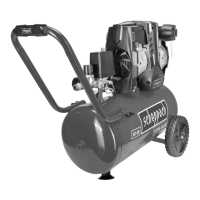10
8.2 Installing the supporting foot (g. 4)
• Fit the supplied supporting foot (7) as shown.
8.3 Installing the air lter (g. 5, 6)
• Remove the transport lid (15) and screw the air lter
(4) to the equipment.
• Insert the hose (4d) into the opening of the air lter
(4).
8.4 Mains connection
• The compressor is equipped with a mains cable
with protective contact plug. This can be connect-
ed to any 220 ‒ 240 V∼ 50 Hz protective contact
socket, with fuse protection of at least 16 A.
• Before you use the machine, make sure that the
mains voltage is the same as the operating voltage
and the machine power on the rating plate.
• Long supply cables, extensions, cable reels, etc.
cause a drop in voltage and can impede motor
start-up.
• At low temperatures below +5 °C, sluggishness
may make starting dicult or impossible.
8.5 On/O switch (g. 1)
• Pull the On/O switch (3) upwards to switch on the
compressor.
• To switch o the compressor, press the On/o
switch (3) down.
8.6 Setting the pressure (g. 1, 2)
• Use the pressure regulator (14) to set the pressure
on the pressure gauge (12).
• The pressure set can be drawn from the quick cou-
plings (10, 11).
• The vessel pressure can be read o at the pressure
gauge (13).
8.7 Setting the pressure switch (g. 1)
• The pressure switch (2) is set at the factory.
Cut-in pressure approx. 6 bar
Cut-out pressure approx. 8 bar
8.8 Fitting the compressed air hose (g. 1, 2)
• Connect the plug nipple of the compressed air
hose (not included in the scope of delivery) to one
of the quick couplings (10, 11). Then attach the
compressed air tool to the quick coupling of the
compressed air hose.
9. Electrical connection
The electrical motor installed is connected and
ready for operation. The connection complies
with the applicable VDE and DIN provisions. The
customer‘s mains connection as well as the ex-
tension cable used must also comply with these
regulations.
When working with spray attachments and during
temporary use outdoors, the device must be con-
nected to a residual current circuit breaker with a
trigger current of 30 mA or less.
9.1 Important information
In the event of overloading, the motor will switch itself
o. After a cool-down period (time varies) the motor
can be switched back on again.
9.2 Damaged electrical connection cable
The insulation on electrical connection cables is of-
ten damaged.
This may have the following causes:
• Pressure points, where connection cables are
passed through windows or doors.
• Kinks where the connection cable has been im-
properly fastened or routed.
• Places where the connection cables have been cut
due to being driven over.
• Insulation damage due to being ripped out of the
wall outlet.
• Cracks due to the insulation ageing.
Such damaged electrical connection cables must not
be used and are life-threatening due to the insulation
damage.
Check the electrical connection cables for damage
regularly. Ensure that the connection cables are dis-
connected from electrical power when checking for
damage.
Electrical connection cables must comply with the
applicable VDE and DIN provisions. Only use con-
nection cables of the same designation.
The printing of the type designation on the connec-
tion cable is mandatory.
9.3 AC motor
• The mains voltage must be 220 ‒ 240 V∼ 50 Hz.
• Extension cables up to 25 m long must have a
cross-section of 1.5 mm
2
.
Connections and repair work on the electrical equip-
ment may only be carried out by electricians.
Please provide the following information in the event
of any enquiries:
• Type of current for the motor
• Data of machine type plate
• Data of motor type plate

